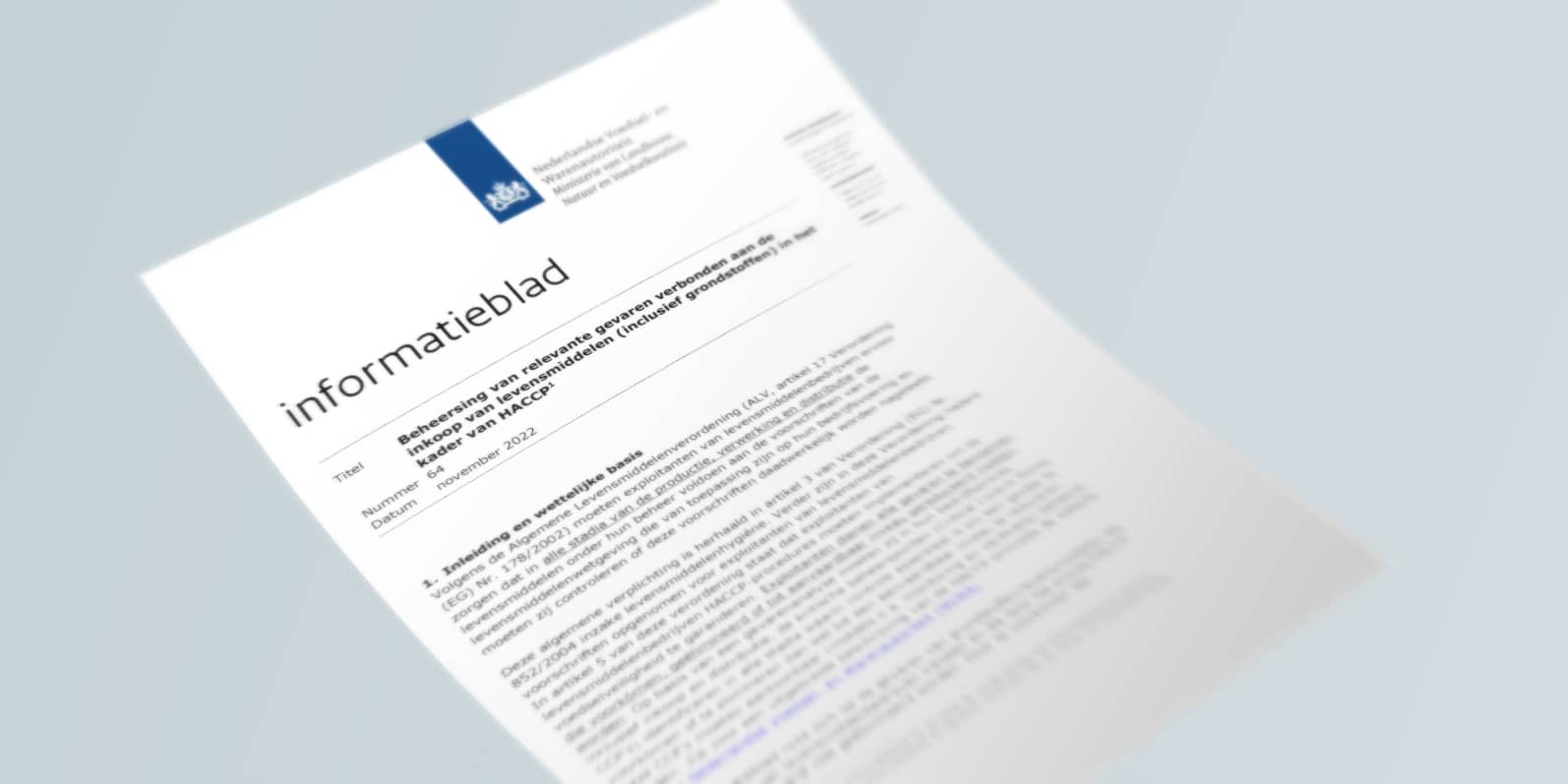Major impact of new version of NVWA info sheet 64
A new version of an NVWA info sheet does make everyone think for a while, especially now that the NVWA is actually enforcing its implementation. This article describes the purpose of info sheet 64, the issues it raises and gives you tips on how to deal with it. Although the principles have not changed, the new version sets the bar high for traders and retail in particular.
Legal basis
Info sheet 64 is about the demonstrable management of food safety hazards related to food procurement (incl. raw materials). It describes the NVWA’s interpretation of the applicable legislation (Regulation (EC) No 178/2002, article 17 and Regulation (EC) No 852/2005, articles 3 and 5). This new version replaces the previous versions of info sheet 64 and info sheet 65, where info sheet 64 described the control of hazards of raw materials and info sheet 65 described the hazards of consumption-ready products. Both topics have now been merged into one document.
Objective
Legislation states that a food company must apply HACCP principles to all stages of the process for which it is responsible. This therefore also applies to the purchasing process. These HACCP principles must ensure that only safe products are procured and that any remaining hazards in its own process are controlled. This must be demonstrable. The info sheet 64 focuses on the hazards that the company can’t control itself and that must be prevented or controlled earlier in the supply chain. It describes the responsibility of different types of companies and indicates how a company should demonstrate control.
Responsible purchasing
A company has the responsibility to only buy food for which the associated significant hazards (that the company can’t control itself) have been demonstrably controlled earlier in the chain. To fulfil this responsibility, it is necessary to at least have identified the significant hazards. As a producer, B2B trader and importer, you must demonstrate that they have been controlled. As a private label owner and as a B2C trader, you have to make agreements with the producer about their control.
The bar is high
So every food company is expected to have at least identified the significant hazards of the products being sourced. There is a big challenge there. It means that the producer, B2B trader and importer must learn about the purchased products and their ingredients. They must identify the associated potential food safety hazards and conduct a risk analysis of these to determine the significant hazards. This is a hefty task, but not a new one. For the private label owner and B2C trader, they must, together with the supplier, identify the significant hazards. This clearly goes beyond what is common in current practice.
Verification control
As it concerns hazards that a company can’t control in its own process, demonstrability focuses on verification of control by the (chain of) supplier(s). As it is virtually impossible to analyse every batch, it is important to demonstrate that the products come from reliable suppliers. By organising the supplier assessment smartly, you can do this efficiently. Here, it is important to consider the role of the direct supplier: which hazards does he control himself (and how) and for which hazards does he depend on his suppliers. Sometimes hazard control can hardly be attributed to one supplier and depends more on the region or the type of product. This should be taken into account in the way of control and how it should be verified.
Certificates
Doing supplier audits or buying from certified suppliers is another way to demonstrate a supplier’s reliability. The info sheet outlines what an audit and the audit report must comply with. The bottom line is that assessment should be done at hazard level, that all hazards are assessed. The report must provide insight into the facts on the basis of which the auditor concludes that the hazard has been controlled.
The info sheet also refers to ketenborging.nl. However, it does place a big disclaimer here: The certificates listed here do not comply because the stated requirements of an audit are not met. With the exception of one certificate: Riskplaza-audit+. This one does comply.
It is not always well understood why a GFSI certificate is not sufficient: it should be good, right? During GFSI audits, however, there is too little time for a thorough review of the control of raw material hazards and the report does not provide enough information either. Therefore, these schemes do not provide sufficient assurance.
RiskPlaza
The NVWA does have sufficient confidence in the RiskPlaza audit+ certificate. Thanks to the linking of the certification scheme to the Riskplaza database for raw material hazards, hazard identification is very careful. The audit protocol guarantees an in-depth audit. The detailed audit report gives insight that the company buys food-safe products. This rewards the NVWA with reduced supervision of certified companies.
Because Riskplaza requires a valid GFSI certificate as a condition, the hazards that the company itself controls are also demonstrably safeguarded. The combination of these certificates provides unique assurance. Therefore, buyers of Riskplaza-audit+ certified suppliers may assume that food safety hazards are controlled. Additional verification actions are no longer required. Purchasing from a Riskplaza-certified supplier therefore delivers huge savings.
Self-confidence about safe products
Certified companies are challenged in the Riskplaza audit to think about relevant hazards and how a company can convince itself (and thus the auditor and also the NVWA) that the hazard is under control. Thanks to this discussion, a company is not easily surprised by questions from buyers or the NVWA. It increases self-confidence that the products being produced are really safe for buyers and consumers. Although Riskplaza is not yet so well-known abroad, companies with the Riskplaza-audit+ certificate and (parts of) the audit report can also easily convince foreign buyers that they are dealing with a reliable supplier. This is thanks to the external independent assessment.

